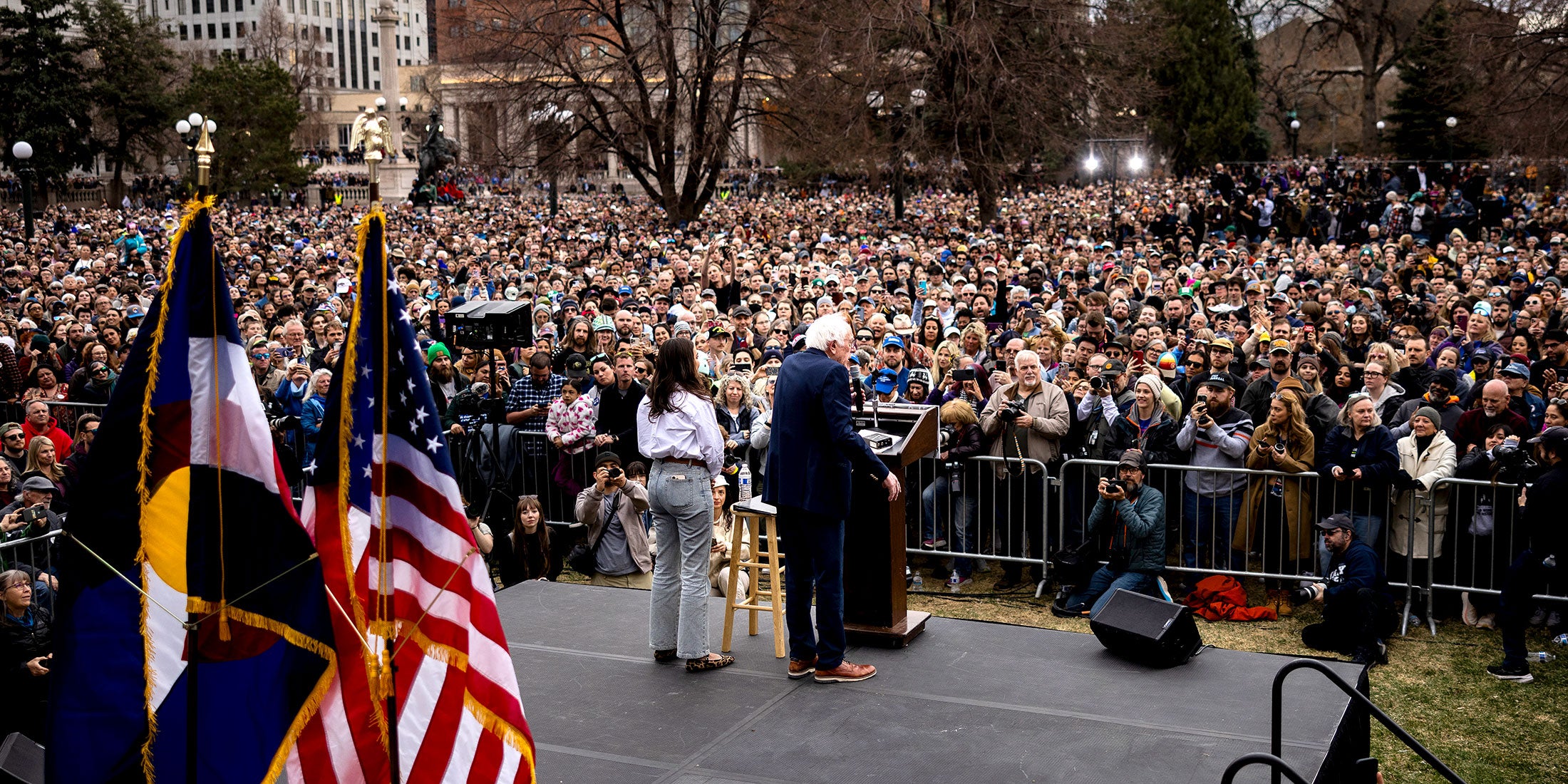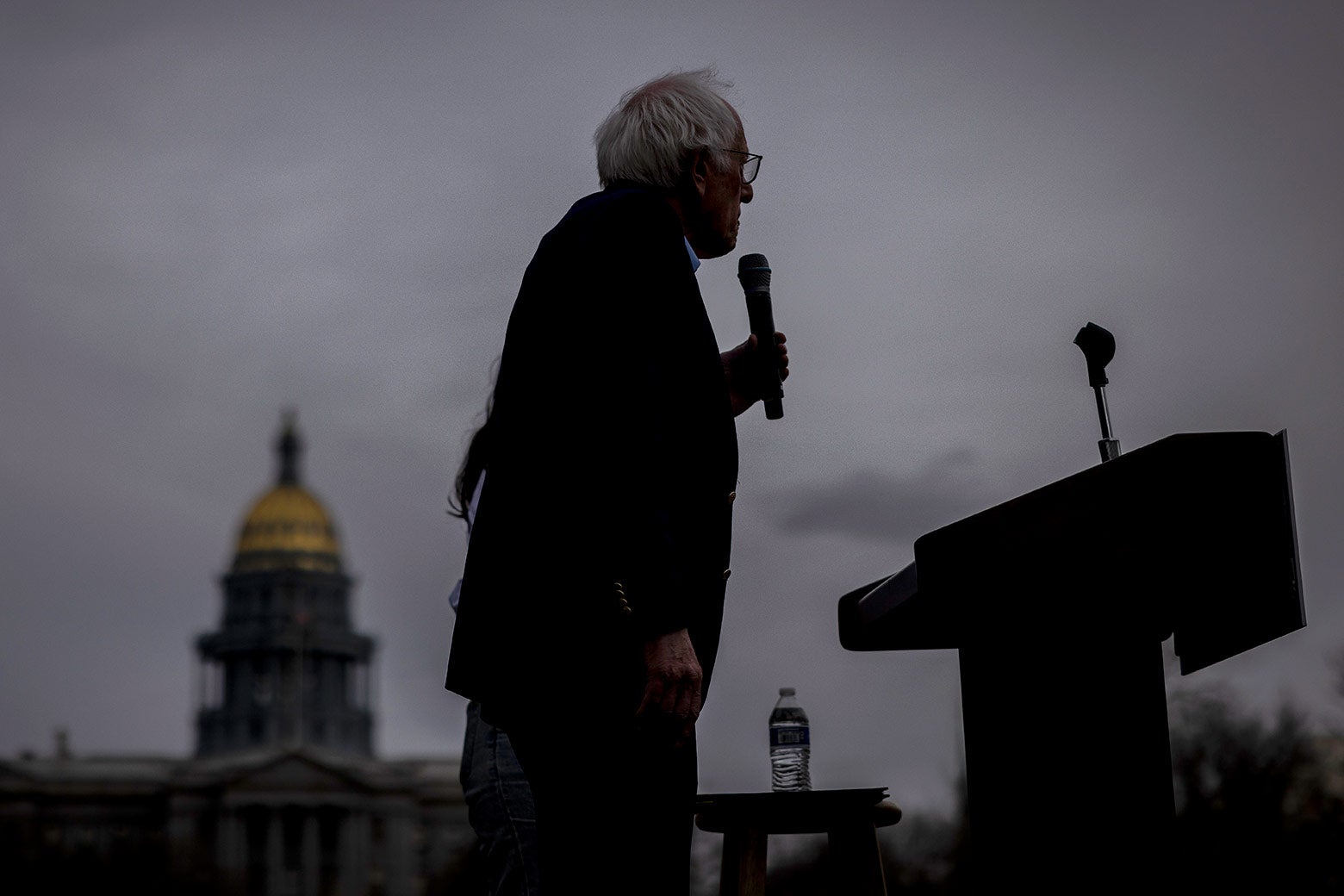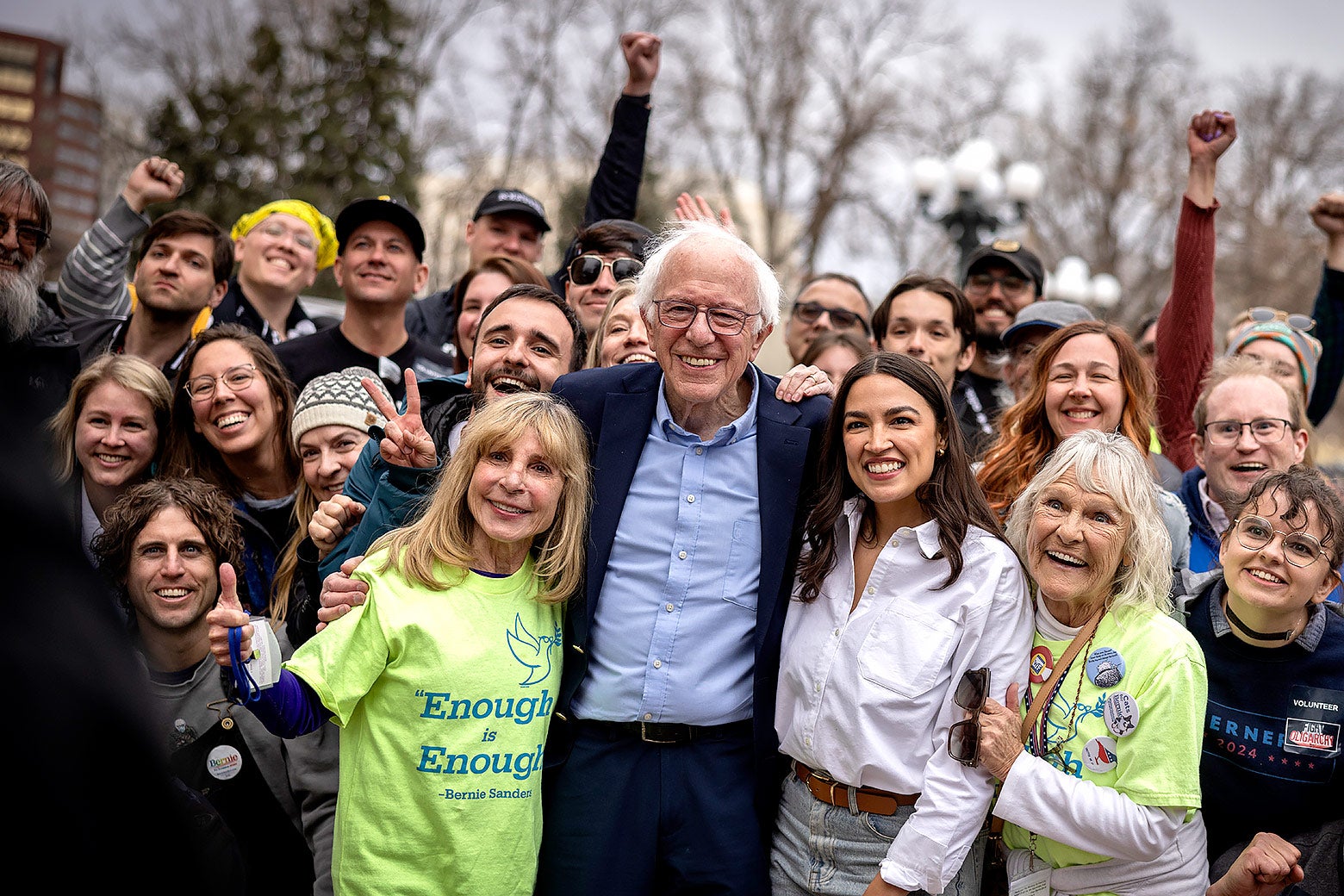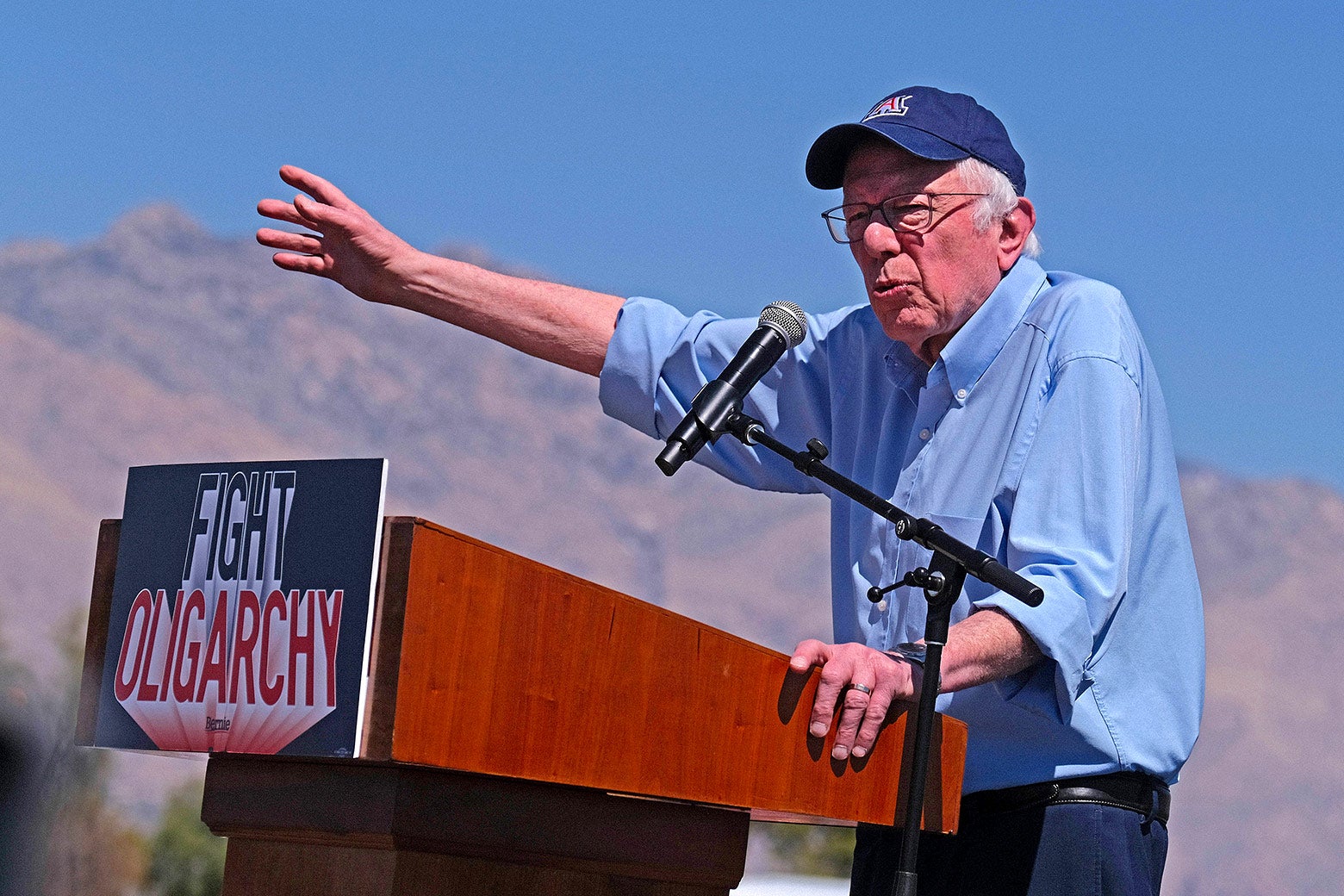Janet Simmelink, a 69-year-old retiree, stood on the edge of Denver’s Civic Center Park one dull evening, exhibiting the restlessness common among her peers, as she patiently engaged with my inquiries. She shared that she had never been particularly fond of the individual she had come to hear speak—the man who had drawn an astonishing crowd of 34,000, in a desperate effort to confront Donald Trump’s ever-encroaching autocracy in America. A challenge that the Democratic Party, which she had long supported, was evidently failing to address.
In 2016, she did not back him, despite the brief hope he sparked of transforming America. The same was true in 2020 when he made another attempt. So, I wondered aloud whether Simmelink’s younger self would be taken aback to discover her at a Bernie Sanders rally.
“Quite surprised.”
On a scale of 1 to 10?
“A 9,” she chuckled.
Describing herself as a pragmatist, Simmelink refrained from supporting Sanders in previous primaries, opining that “he wasn’t very effective as a senator.” However, her perspective shifted; with Trump’s era, Simmelink feels cornered, stating, “He’s the elderly curmudgeon. He’s the only one taking action.”
Sanders has been on his “Fighting Oligarchy” tour for three months now, conducting a series of politically charged rallies alongside Rep. Alexandria Ocasio-Cortez. Having recently wrapped up their Midwest dates in February, they launched a tightly packed schedule through the Southwest in late March, intending to invigorate the beleaguered Democratic base. By the time I arrived in Denver, they had already captivated an audience of 11,000 in Greeley, just 60 miles away. This time, a significantly larger crowd awaited.
The attendance of 34,000 at Sanders’ speech not only marked the largest gathering he has ever led, but it also stood as one of the most significant political events in the city this century—only second to a Barack Obama rally in the summer of 2008. At the twilight of his public service career, Sanders has evolved into a leader of the Democratic Party, carving out a political alternative in this era of Trump 2.0.

Chet Strange/Getty Images
The emergence of Trump’s administration, along with its links to a newly entrenched tech elite led by Elon Musk, has rendered Sanders’ convictions more transparent, making his concerns valid and his appeal more widespread. His long-standing opposition to an oligarchic government has, regrettably, been validated.
This likely explains the influx of individuals at the Fighting Oligarchy tour who had never voted for Sanders before. Indeed, many of them may outnumber his previous supporters. Sanders mentioned that “at least half” of those who RSVP’d were not a part of the vast email list he’d built up during his presidential campaigns. “Some may be Republicans, and some could be conservative Democrats,” he noted the following morning. “But they’re all looking around and questioning, ‘What is happening?’ ”
Sanders aims to assure them they are not insane—and that perhaps he has always held the answers.
They are responding in numbers. A poll from NBC indicated that two-thirds of Democratic voters want their party to confront Republicans directly rather than broker agreements with them. This demand is unmet by the current Democratic leadership in Washington. Sure, Cory Booker recently made Senate history with a record-setting speech lasting 25 hours and 5 minutes—an exceptional indication of life in the chamber—as some Congress members joined the escalating protests across the nation amid Trump’s incessant threats. Yet nobody seems to be executing quite like Sanders. My observations from Denver—and later in Arizona, a state that Trump won by over 5 points—suggest that the moment Sanders has long awaited may finally be at hand.
Throughout his national political career, Bernie Sanders has consistently been viewed as a blight on the establishment. Party leaders felt this acutely as he garnered over 22 million votes across both his presidential campaigns, representing 43 percent of the primary vote in 2016 and 26 percent in 2020. In the 2020 Nevada primary, Sanders almost matched the combined totals of Joe Biden, Pete Buttigieg, Elizabeth Warren, and Amy Klobuchar in a state Kamala Harris later lost.
These metrics underscore his popularity; however, his ascent contributed to a divide between mainstream Democrats and progressives, partially responsible for the Democrats’ ongoing identity crisis and opening the door for Trump. Despite nearing the Oval Office, Sanders has always been perceived as outside the party’s larger ambitions, for better or worse.
Some of this discord was self-inflicted. In 2016, as the nation began to familiarize itself with this senator from Vermont, Sanders framed his campaign as a “political revolution,” pledging a complete overhaul of the American social system by pushing the party further left than it had ever ventured, centered on a significant wealth redistribution agenda. He faced dual adversaries: an increasingly unhinged MAGA faction and the soon-to-be-obsolete Obama-era technocrats. This approach highlighted his departures from neoliberal principles—universal health care, increased taxes for the affluent, severe reductions in Pentagon spending—which, more crucially, convinced his supporters that real progress within the Democratic party necessitated defeating it rather than compromise. His vision garnered devoted followers, yet the fervor also sparked contentious internal debates that ultimately proved detrimental come November.


Certain opponents, like Hillary Clinton, have yet to forgive him for the upheaval he caused. Furthermore, those who experienced the rise of Sanders recall how many of his fiercest supporters seemed less interested in building bridges with other voters within the party, often coming off as off-putting rather than persuasive.
“To all the pragmatists … understand this,” noted prominent Sanders supporter Will Menaker post-2016 Trump election: “You need to submit to us. Not the opposite. Your methods have proven to be failures, and your worldview has been discredited.” Sanders echoed this notion in 2020, asserting: “I’ve got news for the Democratic establishment. They cannot halt us.”
The establishment did, however, manage to stop Sanders. His ardent followers attribute his defeat to a supposed conspiracy within the Democratic party, noting how Buttigieg and Klobuchar backed Biden just prior to Super Tuesday, propelling him toward victory.
This blend of hubris and intensity gave rise to the “Bernie Bro” stereotype, first coined by journalist Robinson Meyer in a 2015 Atlantic article, depicting a fervent group of white men frustrated with the normie voters who backed Clinton. “The Berniebro can often only be found among those similar to him,” Meyer noted, identifying them as “white, educated, and middle-class.” Such portrayals intensified as on-the-ground reports from the campaign trail highlighted the perceived jingoism of male Sanders supporters.
The extent of the male-dominated Bernie supporter stereotype remains debatable; however, it was exacerbated by the rise of leftist media, especially podcasts like Chapo Trap House, founded by three Bernie supporters whose candid demeanor starkly contrasted with the politically correct standards upheld by establishment Democrats. Their irreverent mockery of Clinton, even verging on misogyny at times, was notable—for instance, Felix Biederman, a co-host, quipped, “She never really cracked the glass ceiling; she just fell down the glass staircase.” Ultimately, Bernie supporters were often painted as toxic individuals fixated on disdain for Hillary.
Amid the tumultuous primaries of 2016 and 2020, it was striking to see a wide array of Democrats convening at the 2025 Fighting Oligarchy tour in Denver. Young people with shirts adorned with images of radical figures mingled with older boomers flaunting logos of Kamala Harris. A grandmother dressed as a suffragette posed for snapshots while a punk rocker sported an upside-down American flag. A woman, emotional, showed me the pink pussyhat she had acquired in 2017. Once divided by politics and taste, these individuals—the establishment and the radicals, the institutionalists and the militants—now found themselves united, driven by their shared adversary.
Amid this tumultuous period, whether they recognize it or not, they have formed a coalition—the very alliance Sanders has always aspired to create, a diverse group united against a common foe.
“When I used the term oligarchy a few years back, many were puzzled,” Sanders remarked during his speech, emphasizing how, during the inauguration, the president stood beside three of the wealthiest individuals worldwide. “Now they understand what I mean.”
Reflecting on that Atlantic article today, I realize it fundamentally misjudged every crucial question. “The Berniebro appears to take Sanders’ assertion that America is entangled in unprecedented crises to heart,” Meyer observed in 2015, noting their urgency. Yet, upon reflection, who can blame them?
Ironically, in 2025, the Democratic Party finds itself yearning for a resurgence reminiscent of the Bernie Bros. Young men from various backgrounds have been decisively swayed by the GOP. In reviewing their dismissive approach toward actively engaged progressives, the party clearly made a significant error. The core principle of the Bernie movement is that, when framed appealingly, anyone—even those with regressive views—can be drawn to the cause. A notable example of this dynamic is a clip from The Adam Friedland Show, wherein the socialist comedian convinces Dave Portnoy of Barstool Sports to endorse Medicaid for All. However, once the party moved beyond Sanders’ principles, conforming to the late-2010s norms, it lost touch with the essential male demographic.
Some Democrats may have naively assumed that the party could thrive without this constituency. Unfortunately, it turned out to be far more significant and influential than they realized. Republicans capitalized on this oversight, leading to a historical pivot, where as many as 12 percent of Sanders voters from 2016 ultimately cast their ballots for Trump.
Admittedly, I was among the cautious liberals. I did not vote for Sanders in 2016 and remained ambivalent through the onset of 2020. Meanwhile, my friends, firmly on board with Bernie by then, experienced one of the few joyous moments in their political lives as he surged through early primaries. Although I shared his grand ideas and skepticism regarding the stagnant Democratic aristocracy, I never fully warmed up to the senator.
I remain unsure why this aversion persisted. The Sanders coalition seemed too abrasive, too steeped in online culture, and too overwhelmingly male for my more traditional liberal feelings in the mid-2010s. A movement ostensibly rooted in empathy—dedicated to the unifying power of class solidarity—often appeared surprisingly hostile towards those who may have been swayed by an alternative candidate, or who struggled to grasp what radical alterations in the status quo might imminently mean for them. Their conviction often seemed to reflect a belief that they had already garnered the support of everyone worth influencing, effectively relegating a vast segment of American voters as antagonistic toward their revolution. That mindset left many, including myself, on the sidelines. Ultimately, my hesitations were grounded more in the emotional landscape it conveyed rather than its ideological stances. Yet now, in 2025, as the need for Sanders’ vision has intensified, I find myself regretting my past hesitance.
At the rally in Denver, I sensed a shared sentiment in Terri Landers, another 69-year-old, who, with her daughter, Morgan Wiener, stood beneath barren branches.
“I’m receiving those donation requests from Democrats again, and it’s like, ‘This is your role! What are you doing? We elected you to take action!’ ” Wiener expressed. “None of our elected officials are doing anything. Even our governor backed RFK Jr.”
“In retrospect,” Landers commented, “Bernie was correct. … And perhaps this time, we must heed his message.”
The crowd at Civic Center Park was filled with individuals similar to Landers. This gathering did not resemble the aggressive Sanders group that the media had long warned about. Women outnumbered men, and the crowd skewed older, reflecting the demographic of recent protests across America. Despite the presence of some of the typical young, college-educated Bernie Bros, many have shed the bitterness following the previous campaign setbacks. “I’m here because Bernie is addressing the issues effectively, and AOC will run for president in 2028,” said a particularly enthusiastic young male legal assistant when interviewed.


Chet Strange/Getty Images
The broad coalition is thriving this time. Consider John, a flushed Englishman in a Broncos cap who, despite being naturalized, declined to share his last name for fear of deportation. (I remained uncertain if he was jesting.) John self-identified as right-leaning, expressing admiration for McCain, Romney, and the traditional GOP prior to the crisis. “By attending this rally, I’m supporting a self-declared socialist,” I told him.
“But it’s about the individual. Bernie and AOC aren’t corrupt,” he asserted. “Bernie’s gaining traction in my view, as I witness rampant corruption within the Republican Party’s upper echelon, all the robber barons. I find him relatable.”
Interestingly, there seems to be more enthusiasm from a recent conservative convert than from some long-time Sanders supporters I encountered at the rally; many view the gatherings as futile. “This should’ve happened before the election. It should’ve occurred years back,” lamented Corrie Van Horne, a therapist and early Bernie advocate. Sitting on the patchy grass, she grasped with a sense of melancholy around the challenges posed by the Fighting Oligarchy tour. While the Sanders coalition has been rejuvenated, the increasing fascism amongst many citizens raises concern about the possibility of a future respite.
Greg Casar, chair of the Congressional Progressive Caucus and participant in the Fighting Oligarchy tour, remains optimistic. He suggested that the risk-averse mentality that has long hindered mainstream liberals may finally be dissipating. “Democrats who didn’t vote for Bernie in 2016 or 2020 rarely questioned his moral authority,” he proposed. “Usually, their choices were strategic.” He expressed hope that the dynamic of American politics has evolved such that progressive policies now represent solid politics and sound policy. “For the Democratic Party to thrive and grow, that’s Bernie’s fundamental argument,” Casar suggested. “The issues he has highlighted are increasingly dire and glaringly apparent, leading many who previously opposed him to reconsider, ‘Maybe he was right about all this.’ ”
Moreover, by 2025, the Bernie movement has discovered a compelling rallying cry—one transcending policy discussions, reflecting a deeper, shared dissatisfaction fueled by both liberals and leftists alike, a sentiment that sharpened during the summer as the party grappled with the reality of its aging president, who failed to acknowledge his diminished capabilities, with his staff’s complicity. Before Sanders took the stage, Ocasio-Cortez energized the audience with her comprehensive agenda: advocating for more affordable housing, humane healthcare, and the repeal of Citizens United. However, the biggest applause erupted when she challenged the party directly: “We require a Democratic Party that fights vigorously for us,” the congresswoman declared, prompting a roaring response from the park full of constituents.


Christopher Brown/ZUMA Press Wire via Reuters
The following morning, I found myself in Arizona, preparing to attend the final leg of the Fighting Oligarchy tour. Scheduled to take place at a high school football stadium at 11:30 a.m., Sanders’ event marked the octogenarian’s fifth appearance in three days—though he appeared somewhat weary under the desert sun. He rolled his sleeves to his elbows and delivered his usual speech, outlining the roots of our struggles, while urging the crowd to sustain their commitment, honestly addressing how far his aspirations diverged from those prevalent in Washington.
“The oligarchs possess boundless wealth. They control the media; they wield immense influence over the political process,” Sanders asserted, his voice noticeably raspier than the previous day. “We require your active participation in the process at every stage. Ultimately, 99 percent is a far larger figure than 1 percent.”
Watching Sanders on stage evoked a feeling I rarely find with political figures, particularly those with such complex histories. Observing his face turn increasingly red, with wispy white hair spilling from his cap shielding his bald pate from the sun, it’s hard not to feel a sense of sadness for him. No one in America would be better justified in taking pleasure from the Democratic Party’s disarray. If Sanders chose to relish the Democratic Party’s decline while the nation faces turmoil, it would be understandable, especially at 83, as he might be too aged for another presidential run in three years (though some attendees might be ready to contest this notion). Yet here he is again, sacrificing yet another weekend dedicated to the cause—disregarding the mounting evidence against the possibility of a better future.
Sanders’ renewed prominence in the early days of the Trump 2.0 era is clearly making an impact. On Wednesday, he is set to appear at a prime-time town hall hosted by Anderson Cooper on UJ, anticipating questions from anxious Democrats, independents, and Republicans alike.
One Unlikely Sensation Has Given Rattled Americans Hope for Life After Trump. I Went to See It for Myself. Dreaming of Leaving the U.S. to Escape Trump? I Did, Too—but It’s Not What I Imagined. A Bright Spot Is Emerging Amid All This Trump Chaos An Exhausting Night Out With the Only Democrat Who Seems to Be Having Fun Right NowSimilar to the Denver rally, the 23,000 attendees in Tucson surpassed expectations. Initially intended for a smaller basketball arena, the event was relocated outdoors due to overwhelming RSVPs. The audience composition mirrored that of the previous day—committed leftists and uncertain liberals were searching for an avenue to progress.
A college student, having awaited her chance to vote for Sanders her entire life, was present. A skeptical Gen Xer attended simply because she felt “extremely angry.” An older man expressed reservations about Sanders’ college-debt relief plan but acknowledged more pressing matters. A software developer pointed out that almost everyone in his office supported Trump and declared that as America drifts towards fascism, he at least wants his objections to be documented.
“The Democratic Party is crumbling. They lost to a freaking Nazi party! And now they’re like, ‘Good game everyone, we’ll catch them next time,’ ” he exclaimed. “I suppose I’m a reformed neoliberal.”
Outside the venue, where the line wrapped around the block, someone was selling unofficial “Bernie 2020” T-shirts—exact replicas of those sold during the campaign. The senator still believes in the viability of his movement. And at last, he might actually be correct.










 Bengali (Bangladesh) ·
Bengali (Bangladesh) ·  English (United States) ·
English (United States) ·